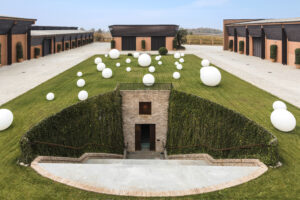
It is not a decline, but a sharp, widely expected slowdown after a long period of enormous growth. The secondary fine wine market, as told by data on February’s Liv-ex 1000 - the benchmark index for wine investors, which monitors the performance of thousands of labels from around the world - marks its fourth consecutive month of decline: -0.8%. Thus, the scenario drawn by the 2022 year-end report, marked by widespread pessimism among Liv-ex members, takes shape: it is very difficult for certain territories and certain labels, which have arrived at very high prices, to continue to grow and guarantee further margins, especially in a complicated economic environment marked by inflation, consumer distrust, and uncertainty.
Since October 2022, the index has lost 2.6%, but in February there is still a sub-index capable of going in the opposite direction: the Italy 100 - which gathers the last ten vintages on the market of Barolo Bartolo Mascarello, Barbaresco Gaja, Barolo Monfortino Riserva Giacomo Conterno, Frescobaldi’s Masseto and Ornellaia, Sassicaia Tenuta San Guido, Antinori’s Solaia and Tignanello, Barolo Falletto Vigna Le Rocche Riserva Bruno Giacosa and Flaccianello della Pieve Fontodi - has marked a +1.1% growth. Credit essentially goes to Piedmontese wines, with excellent performances by Gaja Barbaresco 2015 (+17.4%) and 2011 (+13.2%), Bartolo Mascarello Barolo 2010 (+13.6%) and Giacomo Conterno Barolo Monfortino Riserva 2010 (+11.7%).
On the other hand, the worst figure is that of the Burgundy 150, which loses 2.1%, confirming what many analysts have been saying for some time: the growth of the past two years has been so rapid that a readjustment of prices today was inevitable. Also bad is the Rhone 100, down 1.8%, while Champagne 50, the 2022 positive protagonist of fine wine, after three consecutive months as the worst index, limits its losses to -0.5%, kept afloat by strong recoveries of Bollinger La Grande Annee 2014 (+11.1%), Jacques Selosse Millesime 2009 (+10.1%), Louis Roederer Cristal Rosé 2008 (6.9%) and Dom Perignon 2005 (+6.8%).
Back in positive territory is the Liv-ex 100, which analyzes the price trends of the 100 most sought-after wines on the secondary market (including Bartolo Mascarello’s Barolo 2016, Gaja’s Barbaresco 2018, Giacomo Conterno’s Barolo Monfortino Riserva 2013 and 2014, Frescobaldi’s Masseto 2016 and 2017 and Ornellaia 2018, Poggio di Sotto’s Brunello di Montalcino 2016, Tenuta San Guido’s Sassicaia 2016, 2017, and 2018, Antinori’s Solaia 2018 and Tignanello 2016 and 2018, and new entries Redigaffi 2019 Tua Rita and Barolo Falletto Vigna Le Rocche Riserva 2016 Bruno Giacosa), up 0.4% as of February 2023.
Also on the Liv-ex 100, the best performances included Italian labels: Tignanello 2019 (+4.7%), Masseto 2018 (+4.5%) and Sassicaia 2019 (+2.8%). Better did Bollinger La Grande Année 2014 (+11.1%), Harlan Estate Napa Valley (+9.9%), Domaine de la Romanée-Conti Richebourg Grand Cru (+9.1%), Penfolds Grange (+8%) and Domaine Armand Rousseau Chambertin-Clos de Beze (+7.8%).
Copyright © 2000/2025
Contatti: info@winenews.it
Seguici anche su Twitter: @WineNewsIt
Seguici anche su Facebook: @winenewsit
Questo articolo è tratto dall'archivio di WineNews - Tutti i diritti riservati - Copyright © 2000/2025